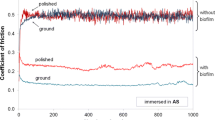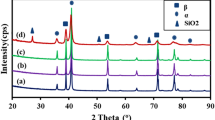Abstract
The negative effect of fluoride ions on titanium has been known in dentistry for a long time. The presented work was aimed at the interaction between titanium and model saliva following a short-term exposure of a specimen to a model medical preparation rich in fluoride ions. The experimental work was carried out using titanium grade 2 in a physiological solution (pH non-adjusted, 5.8, 4.2; 5000 ppm F−) and in model saliva. Electrochemical measurement techniques were supplemented with XPS analysis. The presence of fluoride ions resulted in partial degradation of the passive layer even in a slightly acidic environment. The decrease of pH to the value of 4.2 and the presence of 5000 ppm F− caused titanium activation followed by a slow repassivation in model saliva. Formation of low soluble compound rich in fluorine explains experimental data. Short medical treatment can result in relatively long period of increased titanium corrosion.








Similar content being viewed by others
References
Jones DA. Principles of prevention of corrosion. Upper Saddle River: Prentice Hall; 1995.
Cohen F, Chemla M, Burdairon G. Corrosive properties of odontologic fluoride-containing gels against titanium. Comptes Rendus de l’Academie des Sciences, Serie II. 1991;313:501–8.
Boere G. Influence of fluoride on titanium in an acidic environment measured by polarization resistance technique. J Appl Biomat. 1995;6:283–8.
Johansson BI, Bergman B. Corrosion of titanium and amalgam couples: effect of fluoride, area size, surface preparation and fabrication procedures. Dent Mater. 1995;11:41–6.
Kononen MH, Lavonius ET, Kivilahti JK. SEM observations on stress corrosion cracking of commercially pure titanium in a topical fluoride solution. Dent Mater. 1995;11:269–72.
Toumelin-Chemla F, Rouelle F, Burdairon G. Corrosive properties of fluoride-containing odontologic gels against titanium. J Dent. 1996;24:109–15.
Ozeki K, Oda Y, Sumii T. The influence of fluoride prophylactic agents on the corrosion of titanium and titanium alloys. Shika Gakuho. 1996;96:293–304.
Strietzel R, Hosch A, Kalbfleisch H, Buch D. In vitro corrosion of titanium. Biomaterials. 1998;19:1495–9.
Arys A, Philippart C, Dourov N, He Y, Le QT, Pireaux JJ. Analysis of titanium dental implants after failure of osseointegration: combined histological, electron microscopy, and x-ray photoelectron spectroscopy approach. J Biomed Mater Res. 1998;43:300–12.
Joska L, Venclikova Z, Poddana M, Benada O. The mechanism of gingiva metallic pigmentations formation. Clin Oral Invest. 2009;13:1–7.
Nakagawa M, Matsuya S, Shiraishi T, Ohta M. Effect of fluoride concentration and pH on corrosion behavior of titanium for dental use. J Dent Res. 1999;78:1568–72.
Fovet Y, Gal JY, Toumelin-Chemla F. Influence of pH and fluoride concentration on titanium passivating layer: stability of titanium dioxide. Talanta. 2001;53:1053–63.
Titanoff N, Manwell MA, Zameck RN, Grosso JE. Clinical and microbiological effects of daily brushing with either NaF or SnF2 gels in subjects with fixed or removable dental prostheses. J Clin Periodontol. 1989;16:284–90.
Lindholm-Sethson B, Ardlin BI. Effects of pH and fluoride concentration on the corrosion of titanium. J Biomed Mater Res A. 2008;86A:149–59.
Stájer A, Ungvári K, Pels IK. Corrosive effects of fluoride on titanium: Investigation by X-ray photoelectron spectroscopy, atomic force microscopy, and human epithelial cell culturing. J Biomed Mater Res A. 2008;87A:450–8.
Marek M. The effect of tin in the Ag-Hg phase of dental amalgam on dissolution of mercury. Dent Mater. 1997;13:353–9.
CRC. Handbook of chemistry and physics. 89th ed, electronic ed. London: Taylor and Francis. http://www.hbcpnetbase.com/ (2008). Accessed 4 Feb 2009.
Orazem ME, Tribollet B. Electrochemical impedance spectroscopy. Hoboken: Wiley; 2008.
Barsoukov E, MacDonald R. Impedance spectroscopy: theory, experiment, and applications. 2nd ed. Hoboken: Wiley; 2005.
Cottis B, Turgoose S. Corrosion testing made easy: impedance and noise analysis. Houston: NACE; 1999.
NIST. X-ray photoelectron spectroscopy database. Version 4.0. Gaithersburg: NIST. http://srdata.nist.gov/xps2 (2008). Accessed 8 Feb 2009.
James WJ, Johnson JW. Titanium, zirconium and hafnium. In: Bard AJ, Parsons R, Jordan J, editors. Standard potentials in aqueous solution. New York: Marcel Dekker; 1985. p. 539–47.
Pourbaix MJN. Atlas of electrochemical equilibriums in aqueous solutions. 2nd ed. Houston: NACE; 1974.
Al-Mayouf AM, Al-Swayih AA, Al-Mobarak NA. Effect of potential on the corrosion behavior of a new titanium alloy for dental implant applications in fluoride media. Mater Corros. 2004;55:88–94.
Huang H-H. Effects of fluoride concentration and elastic tensile strain on the corrosion resistance of commercially pure titanium. Biomaterials. 2002;23:59–63.
Huang H-H. Effect of fluoride and albumin concentration on the corrosion behavior of Ti-6Al-4 V alloy. Biomaterials. 2003;24:275–82.
Mabilleau G, Bourdon S, Joly-Guillou ML, Filmon R, Basle MF, Chappard D. Influence of fluoride, hydrogen peroxide and lactic acid on the corrosion resistance of commercially pure titanium. Acta Biomater. 2006;2:121–9.
Takemoto S, Hattori M, Yoshinari M, Kawada E, Oda Y. Corrosion behavior and surface characterization of titanium in solution containing fluoride and albumin. Biomaterials. 2004;26:829–37.
Acknowledgements
This study was supported by the research programme MSM 6046137302 (Ministry of Education, Youth and Sports of the Czech Republic) and, in part, by a grant 106089003 from the ICT Prague to J. Fojt.
Author information
Authors and Affiliations
Corresponding author
Rights and permissions
About this article
Cite this article
Joska, L., Fojt, J. Corrosion behaviour of titanium after short-term exposure to an acidic environment containing fluoride ions. J Mater Sci: Mater Med 21, 481–488 (2010). https://doi.org/10.1007/s10856-009-3930-y
Received:
Accepted:
Published:
Issue Date:
DOI: https://doi.org/10.1007/s10856-009-3930-y




